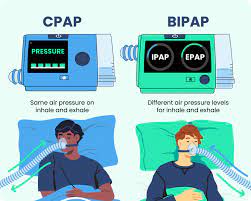
What is the difference between a CPAP and a BIPAP Machine ?
CPAP (Continuous Positive Airway Pressure) and BiPAP (Bilevel Positive Airway Pressure) are both types of non-invasive ventilation machines used in the treatment of respiratory disorders, particularly sleep apnea. While they have similar goals in maintaining open airways and improving breathing, they operate differently and are prescribed for different clinical situations based on a patient's needs. Here are the key differences between CPAP and BiPAP machines:
Pressure Levels:
CPAP: CPAP machines deliver a single continuous pressure throughout the breathing cycle. This constant pressure helps keep the airway open during both inhalation and exhalation. CPAP is typically used for obstructive sleep apnea (OSA) and some other respiratory conditions where a constant pressure is sufficient.
BiPAP: BiPAP machines provide two different pressure levels: a higher pressure during inhalation (inspiratory positive airway pressure, IPAP) and a lower pressure during exhalation (expiratory positive airway pressure, EPAP). This dual-pressure approach is useful for patients who have trouble exhaling against a high continuous pressure. BiPAP is often prescribed for central sleep apnea, complex sleep apnea, and patients with certain lung or neuromuscular disorders.
Patient Comfort:
CPAP: Some individuals find it challenging to exhale against the constant pressure of a CPAP machine. This can lead to discomfort and reduced compliance with therapy, particularly in patients with conditions that affect their ability to breathe out against resistance.
BiPAP: BiPAP machines can be more comfortable for certain patients because the lower pressure during exhalation makes it easier to breathe out. This can enhance patient compliance and comfort, especially for those who struggle with higher CPAP pressures.
Prescription and Medical Assessment:
CPAP: CPAP is often the initial treatment for most cases of obstructive sleep apnea and is prescribed based on the results of a sleep study (polysomnography) that measures a patient's breathing patterns during sleep.
BiPAP: BiPAP is typically prescribed when a patient's sleep study or clinical assessment indicates a need for more advanced therapy, such as in cases of central sleep apnea, respiratory muscle weakness, or insufficient response to CPAP therapy.
Cost:
CPAP: CPAP machines are generally less expensive than BiPAP machines because they have a simpler design and operate at a single pressure.
BiPAP: BiPAP machines are more complex due to their dual-pressure capability, which can make them more expensive.
In summary, the primary difference between CPAP and BiPAP machines is the way they deliver pressure. CPAP provides a constant pressure, while BiPAP delivers two different pressures during the breathing cycle. The choice between CPAP and BiPAP depends on the specific respiratory condition and the comfort and needs of the patient as determined by a healthcare professional.

